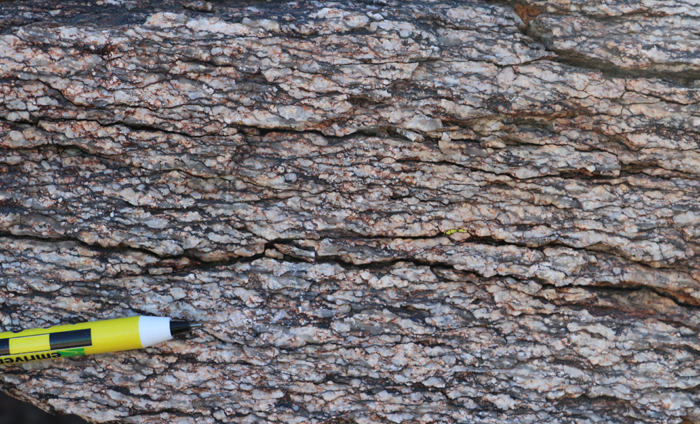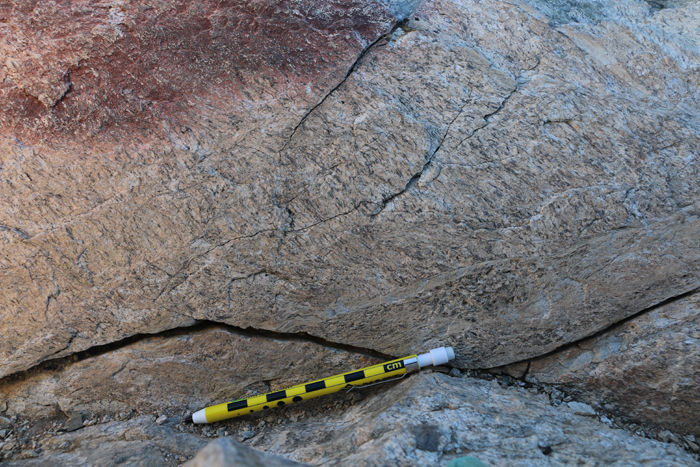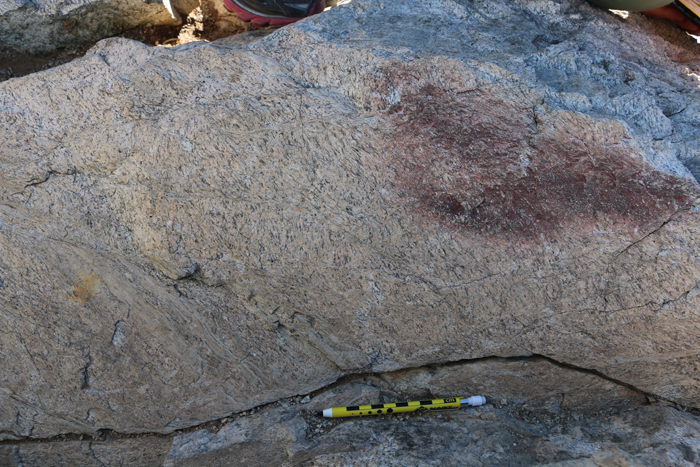10 January 2018
SGTF field trip
Posted by Callan Bentley
I spent last weekend at the 5th biennial Structural Geology and Tectonics Forum, hosted by Arizona State University in Tempe, Arizona. It was an excellent meeting, full of new insights for me, new connections, and opportunities to share stuff I’ve been working on.
The four day Forum began with a field trip to the Phoenix Mountains and the South Mountains. I’d like to share a few images from the trip here today.
We began in the Phoenix Mountains, at a public park called Dreamy Draw. Crossing under the highway, we were able to explore some more terrain to the north.

Our leader was Steve Reynolds of ASU:

He came equipped with a well-used sketchpad on which were drawn useful diagrams to explain the geology of the area:

Clearly, it’s not the first time he or co-leaders Julia Johnson, Ramón Arrowsmith, or Steve Semken have led people to see these rocks.
As you can see from the sketch, the structure of the Phoenix Mountains is a series of upright metasedimentary and metavolcanic rocks, folded into two isoclinal synclines separated by a fault.
In the limbs of these folds, the cleavage and bedding were close to parallel: both stood up vertically or close to it:


There were some quartz veins cutting across the bedding and cleavage, and also a few small kink folds, like these:


In some spots, there appears to have been a volcaniclastic component to the sediments: little white balls of pumice that got dropped into an otherwise muddy sedimentary package. When deformed, these pumice blobs got stretched out, forming a nice lineation that lies within the plane of foliation:

Here’s a second example of this LS tectonite:

We lunched enjoyably at Los Dos Molinos, a legendary Mexican restaurant on the south side of town.
Then it was up into the South Mountains, the largest municipal park in the United States at over 15,000 acres.
We went there to look at the footwall of the metamorphic core complex exposed there.

This was a site where the Phoenix Mountains’ granite and gneiss were uplifted, as the rocks on top slid off the top. There is a detachment fault (a low-angle normal fault), but the story is more intriguing than that, as the rocks beneath the fault show ductile deformational fabrics – low-angle mylonitic foliation. The rocks here flowed into a new shape while the rocks just above were breaking and sliding.
Here’s a look across a small canyon to see the strong mylonitic cleavage in its almost-horizontal orientation, controlling the weathering of the deformed granites near Dobbins Overlook:

Out in the distance, in the Phoenix Basin, are huge chunks of rock that slid off the top of the South Mountains, with just little nubbins poking up, iceberg-style above the sedimentary basin fill.
The granites in the footwall are equigranular at lower elevations (greater depths), but show an increasing penetrative fabric the higher in the mountain (and the closer to the detachment fault) you go. They are both foliated and lineated:


The mylonites are beautiful in outcrop: smeared-out granite is lovely stuff:


This outcrop is the source of the S-C mylonite depicted as the “textbook” example in the Davis, Reynolds, and Kluth structural geology textbook:

Note the different foliations in this next outcrop, ans mylonitic smearing accommodated rotation of blocks of granite within the metamorphic core complex’s footwall:


There are veins of pseudotachylyte here too: dark bands of fault glass that cut across the mylonitic fabrics, an indication that brittle conditions succeeded ductile conditions:

Pseudotachylyte is generated when frictional grinding of one rock on another during an earthquake instantaneously melts the rock along the fault. This melt freezes moments later, rendering a seam of glass: a “fossil earthquake!”


More veins of pseudotachylyte:


Ironically, conditions then reverted back to ductile – but only on these warm pseudotachylyte veins, which were rheologically weaker than their surroundings. Though solid, the glass seams were capable of flowing under lesser stresses than the rock around them, where the atoms were all bonded together in a network of strong minerals.

So: many of the pseudotachylytes have a mylonitic overprint!

The South Mountains is one of the first places where metamorphic core complexes were first identified by Steve Reynolds back in the late 1970s and early 1980s. It was exciting to visit, and I’d love to go back and explore a bit beyond Dobbins Overlook, where there was a pretty heavy visitation impact: a lot of people, and a lot of litter. The rocks make up for it, of course, but I’d love to roam around there more to get a better sense of the structure of a metamorphic core complex footwall.
Next up, we’ll visit some of the rocks from the hanging wall, which have been transported ~40 km away thanks to the detachment fault. Stay tuned…


 Callan Bentley is Associate Professor of Geology at Piedmont Virginia Community College in Charlottesville, Virginia. He is a Fellow of the Geological Society of America. For his work on this blog, the National Association of Geoscience Teachers recognized him with the James Shea Award. He has also won the Outstanding Faculty Award from the State Council on Higher Education in Virginia, and the Biggs Award for Excellence in Geoscience Teaching from the Geoscience Education Division of the Geological Society of America. In previous years, Callan served as a contributing editor at EARTH magazine, President of the Geological Society of Washington and President the Geo2YC division of NAGT.
Callan Bentley is Associate Professor of Geology at Piedmont Virginia Community College in Charlottesville, Virginia. He is a Fellow of the Geological Society of America. For his work on this blog, the National Association of Geoscience Teachers recognized him with the James Shea Award. He has also won the Outstanding Faculty Award from the State Council on Higher Education in Virginia, and the Biggs Award for Excellence in Geoscience Teaching from the Geoscience Education Division of the Geological Society of America. In previous years, Callan served as a contributing editor at EARTH magazine, President of the Geological Society of Washington and President the Geo2YC division of NAGT.
Very nice and richly annotated documentation of the trip, Callan — as per usual with you—thanks!
Thanks for “peer reviewing,” Steve!